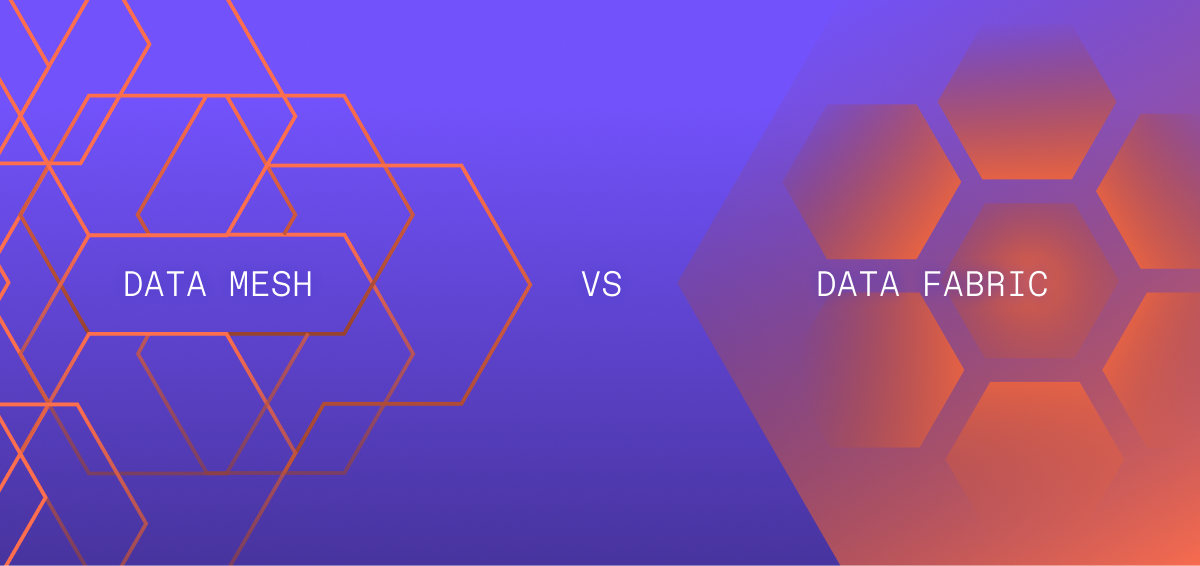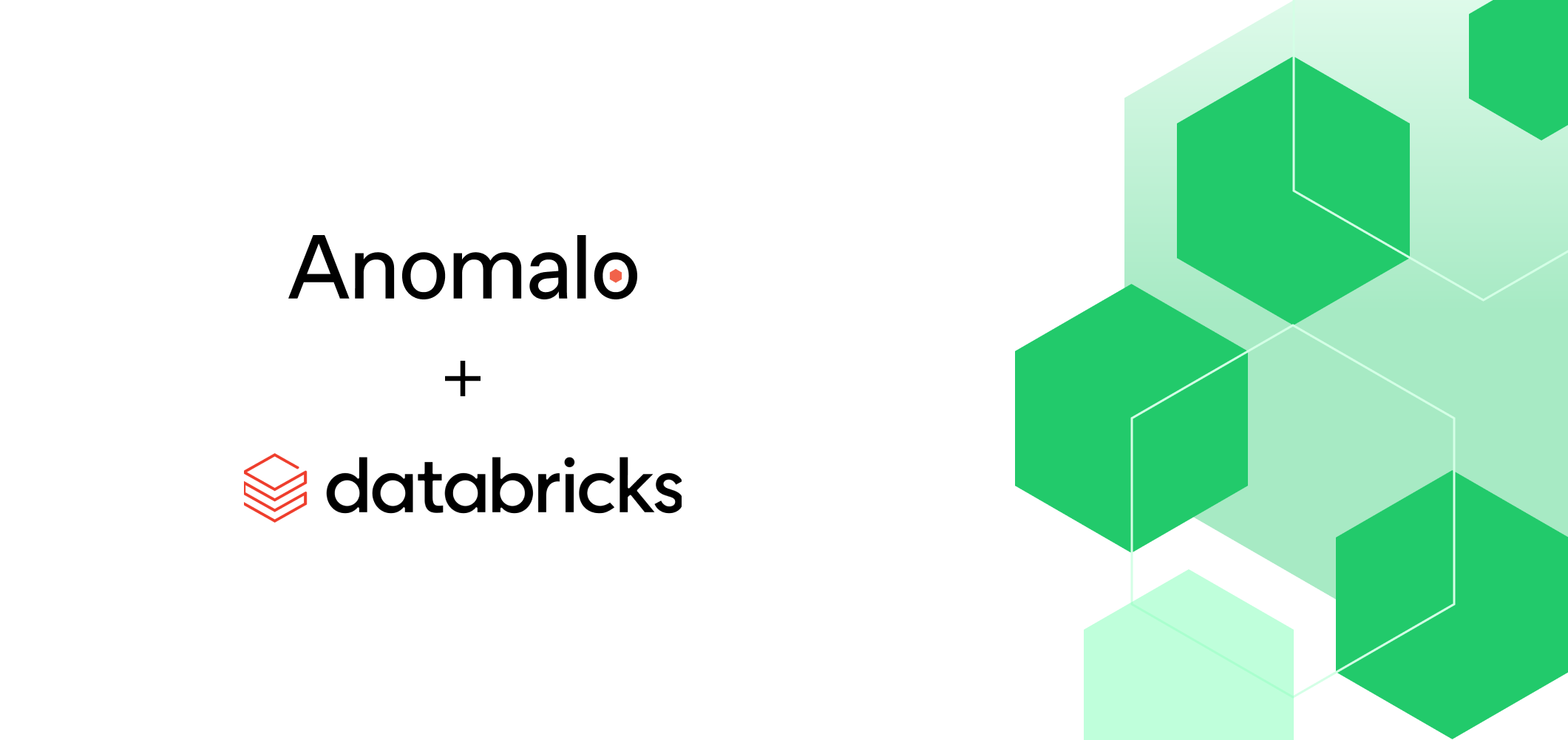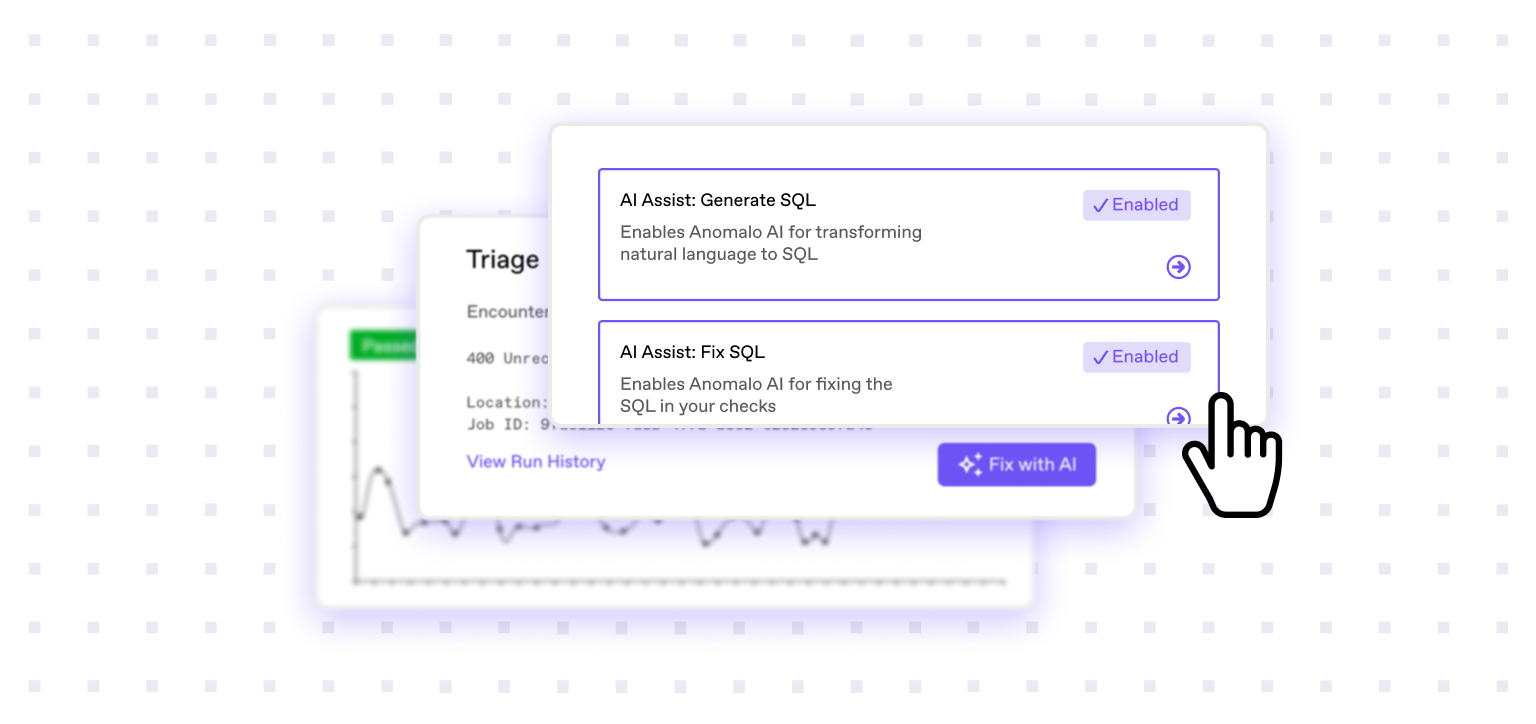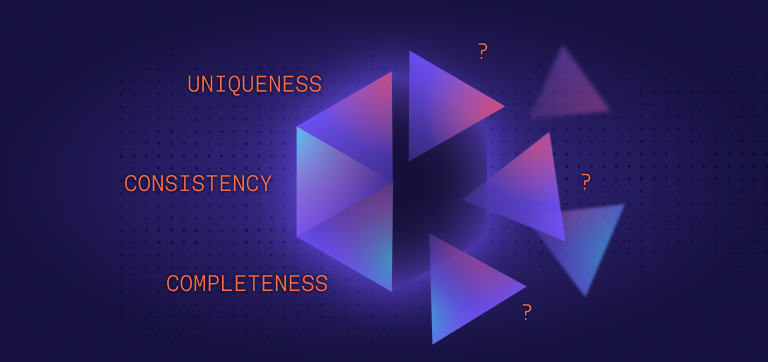Understanding Data Mesh vs Data Fabric: An In-Depth Comparison
April 2, 2024

In today’s data-driven landscape, organizations are grappling with the complexities of managing and harnessing the ever-increasing volumes of data. Effective data management strategies have become paramount for organizations to derive actionable insights, drive innovation, and maintain a competitive edge.
Two prominent approaches have emerged in recent years: Data Mesh and Data Fabric. In this blog post, we delve into the core concepts, architectural differences, implementation challenges, and decision-making considerations surrounding these two paradigms.
Data Mesh: Core Concepts and Principles
What is Data Mesh?
Data Mesh is a decentralized approach to data management and architecture, pioneered by Thoughtworks. It challenges the traditional centralized data lake or data warehouse models, where data is siloed and under the control of a central team. Instead, Data Mesh focuses on domain-driven data ownership, where individual business domains are responsible for their data products.
Key Components
The Data Mesh architecture revolves around four key components:
1. Domain-Oriented Decentralized Data Ownership: Data is owned and managed by the individual business domains that generate and consume it, fostering greater accountability and domain expertise.
2. Data as a Product: Data is treated as a product, with clear ownership, quality standards, and APIs for consumption.
3. Self-Serve Data Platform: There is a centralized platform for working with data that supports many different business roles in a self-service way.
4. Federated Data Architecture: Data is distributed across different domains, with a federated architecture enabling data sharing and integration.
Data Fabric: Core Concepts and Principles
What is Data Fabric?
Data Fabric is a unified data management approach that aims to create a seamless and interconnected data ecosystem. It emphasizes interoperability, governance, and the integration of disparate data sources, enabling organizations to access and analyze data from various systems and locations.
Key Components
The key components of the Data Fabric approach include:
1. Unified Data Architecture: Data is organized and managed within a centralized, cohesive architecture, enabling data sharing and accessibility across the organization.
2. Interoperability: The ability to integrate and communicate seamlessly between different data sources, systems, and technologies.
3. Metadata Management: Comprehensive metadata management to ensure data lineage, quality, and governance.
4. Governance and Security: Robust data governance and security measures to maintain data integrity, compliance, and access control.
Architectural Differences
Data Ownership and Governance
Data Mesh follows a decentralized approach, where data ownership and governance are distributed among individual business domains. This allows for greater agility, as domains can make decisions and implement changes without relying on a central team. However, it also introduces the challenge of aligning with global data standards and policies across the organization.
In contrast, Data Fabric adopts a centralized approach, with a unified data architecture and centralized governance. This centralized model ensures consistent data quality, standards, and management across the enterprise. However, it may lead to slower decision-making processes and potential bottlenecks, as all changes need to go through a central team.
Data Integration Approaches
Data Mesh relies on a federated integration approach, where data is shared and integrated across different domains through APIs and data products. This federated model enables domains to innovate and build tailored data products to meet their specific needs. However, it also increases the complexity of managing and governing data across multiple integration points.
Data Fabric, on the other hand, emphasizes a unified integration approach, where data is centrally managed and integrated within a cohesive architecture. This centralized integration model simplifies how you manage and access data, but may limit the flexibility and agility of individual domains to build custom data solutions.
Scalability and Flexibility
Data Mesh is designed to be highly scalable, as individual domains can independently manage and scale their data products. This decentralized approach allows domains to adapt quickly to changing business requirements and scale their data capabilities as needed. However, maintaining consistency and adherence to global standards across a highly distributed architecture can be challenging.
Data Fabric, while potentially less scalable from a domain-specific perspective, offers greater flexibility in data integration and access across the enterprise. With data centrally managed and governed, it becomes easier to scale data access and analytics capabilities organization-wide. However, this centralized model may limit the ability of individual domains to rapidly scale their data capabilities independently.
Implementation Challenges
Data Quality and Consistency
In a Data Mesh architecture, maintaining consistent data quality and standards across decentralized domains can be challenging. While each domain may have its own quality controls and processes, ensuring enterprise-wide consistency requires robust governance frameworks, data lineage tracking, and cross-domain collaboration.
Data Fabric, with its centralized approach, may have an inherent advantage in ensuring data quality and consistency, as data is managed and governed by a central team. However, it may also face challenges in managing diverse data sources and ensuring data quality at the point of ingestion, especially when dealing with external or third-party data sources.
Cultural Shifts and Organizational Readiness
Both Data Mesh and Data Fabric require significant cultural shifts within organizations, but the nature of these shifts differs. Data Mesh necessitates a culture of decentralized data ownership and accountability, where business domains take responsibility for their data products. This shift may be challenging for organizations with a deeply ingrained centralized data management culture.
On the other hand, Data Fabric demands a mindset shift towards centralized data governance and integration. Organizations accustomed to siloed data ownership may face resistance to relinquishing control and adhering to centralized data policies and standards.
Effective change management and clear communication of the benefits of each approach are crucial for successful adoption.
Technology Stack and Integration Complexity
Implementing a Data Mesh architecture may require specialized tools and technologies to support federated data integration and domain-specific data products. Data Fabric, while potentially leveraging existing data management tools, may face integration complexities when consolidating disparate data sources.
Choosing the Right Approach
The decision to adopt Data Mesh or Data Fabric should be based on an organization’s specific needs, organizational structure, data complexity, existing infrastructure, and desired levels of data governance and control. Organizations with a more decentralized structure and a strong culture of domain-driven ownership may find Data Mesh more suitable, while those with a centralized approach and a need for tighter governance may gravitate towards Data Fabric.
Technological Enablers
Tools and Technologies Aligned with Data Mesh
Data Mesh implementations may leverage tools and technologies such as Apache Kafka for event streaming, domain-driven design principles, and microservices architectures to support federated data integration and domain-specific data products. Additionally, data mesh platforms and frameworks (e.g., AWS Lake Formation) may provide a foundation for implementing Data Mesh principles and best practices.
Tools and Technologies Aligned with Data Fabric
Data Fabric implementations may utilize data virtualization technologies, data catalogs, and metadata management tools, as well as established data integration platforms and data governance solutions. Cloud-based data fabrics, such as those offered by major cloud providers (e.g., Microsoft Fabric), provide comprehensive data management capabilities and seamless integration with cloud services.
Interoperability Challenges and Solutions
Ensuring interoperability between the tools and technologies associated with Data Mesh and Data Fabric can be challenging. Adopting open standards, leveraging APIs, and implementing robust data governance frameworks can help mitigate these challenges. Additionally, hybrid approaches that combine elements of both Data Mesh and Data Fabric may require specialized integration tools and techniques to enable seamless communication and data sharing across the different architectures.
Benefits and Drawbacks
Advantages of Adopting Data Mesh
- Improved data ownership and accountability within business domains
- Enhanced scalability and agility in data management
- Fostered innovation and domain-specific data product development
By decentralizing data ownership to individual domains, Data Mesh promotes greater accountability and domain expertise in data management. Domains have the autonomy to make decisions and implement changes quickly, leading to improved agility. Additionally, the data-as-a-product mindset encourages domains to innovate and develop tailored data products that meet their specific needs, driving business value.
Drawbacks and Limitations
- Potential data silos and inconsistencies across domains
- Increased complexity in maintaining global data governance and standards
- Organizational readiness and cultural shifts required
While Data Mesh offers benefits, it also introduces challenges. With decentralized ownership, there is a risk of data silos emerging across domains, leading to potential inconsistencies and difficulties in achieving a unified view of enterprise data. Maintaining global data governance and adherence to standards becomes more complex in a distributed architecture. Furthermore, successful implementation requires significant organizational readiness and a cultural shift towards domain-driven data ownership.
Advantages of Adopting Data Fabric
- Centralized data governance and control
- Improved data accessibility and interoperability
- Streamlined data integration and management
Data Fabric provides centralized data governance and control, ensuring consistent data quality, security, and compliance across the organization. By unifying data sources and systems, Data Fabric improves data accessibility and interoperability, enabling seamless data sharing and analysis. Additionally, the centralized approach streamlines data integration and management processes, reducing complexity and redundancy.
Drawbacks and Limitations
- Potential bottlenecks and scalability challenges
- Complexity in managing diverse data sources and technologies
- Resistance to cultural shifts towards centralized data control
While Data Fabric offers benefits, it may face scalability challenges and potential bottlenecks as data volumes and demands increase, particularly in large enterprises. Managing diverse data sources and technologies within a centralized architecture can be complex, requiring robust integration capabilities. Additionally, organizations may encounter resistance to the cultural shift towards centralized data control, especially in cases where data ownership was previously decentralized.
Future Trends and Evolving Landscape
Potential Evolution of Data Mesh
As Data Mesh matures, we may see the development of more robust tools and frameworks to support federated data governance, cross-domain data lineage tracking, and automated data product discovery and management. Additionally, the incorporation of machine learning and artificial intelligence could assist in automating data quality checks, metadata management, and data product recommendations across domains.
Innovations in Data Fabric
Data Fabric is likely to evolve with advancements in data virtualization, metadata management, and automated data integration technologies. The use of machine learning and artificial intelligence may enhance data fabric capabilities, such as automating data mapping, transformation processes, and data quality checks. Furthermore, the integration of data fabrics with cloud-native architectures and containerization technologies could facilitate more seamless and scalable data management across hybrid and multi-cloud environments.
Synergies and Collaborations Between the Approaches
While Data Mesh and Data Fabric may seem divergent, there is potential for synergies and collaborations between the two approaches. Organizations may explore hybrid models, where Data Mesh principles are applied within business domains, while a centralized Data Fabric layer provides overarching governance, integration, and accessibility.
Decision-making Considerations for Organizations
When choosing between Data Mesh and Data Fabric, organizations should carefully evaluate their existing data architectures, data management processes, organizational structures, and cultural readiness. It is crucial to consider factors such as scalability requirements, data complexity, regulatory compliance needs, and the desired balance between decentralized ownership and centralized governance. Additionally, organizations should assess the long-term implications and future-proofing considerations to ensure their chosen approach aligns with their evolving data management needs.
Conclusion
In the rapidly evolving data landscape, organizations face the challenge of effectively managing and leveraging their data assets. Data Mesh vs Data Fabric represent two distinct approaches to data management, each with its own strengths, challenges, and applicability.
Data Mesh offers a decentralized, domain-driven approach that fosters data ownership, accountability, and scalability. It empowers business domains to innovate and develop tailored data products while enabling federated data integration. However, it requires a cultural shift towards decentralized data governance and may introduce challenges in maintaining consistency across domains.
On the other hand, Data Fabric provides a centralized, unified approach to data management, ensuring consistent data governance, accessibility, and interoperability. It offers streamlined data integration and management but may face scalability challenges and resistance to centralized data control.
Ultimately, the choice between Data Mesh and Data Fabric depends on an organization’s specific requirements, existing infrastructure, organizational culture, and customer data management goals. Some data teams may even consider hybrid models that combine elements of both approaches.
As data continues to be a strategic asset, organizations must proactively evaluate and adopt the data management strategies that best align with their objectives. By understanding the principles, trade-offs, and evolving landscape of Data Mesh and Data Fabric, organizations can make informed decisions and position themselves for long-term success in the data-driven era.
Get Started
Meet with our expert team and learn how Anomalo can help you achieve high data quality with less effort.


